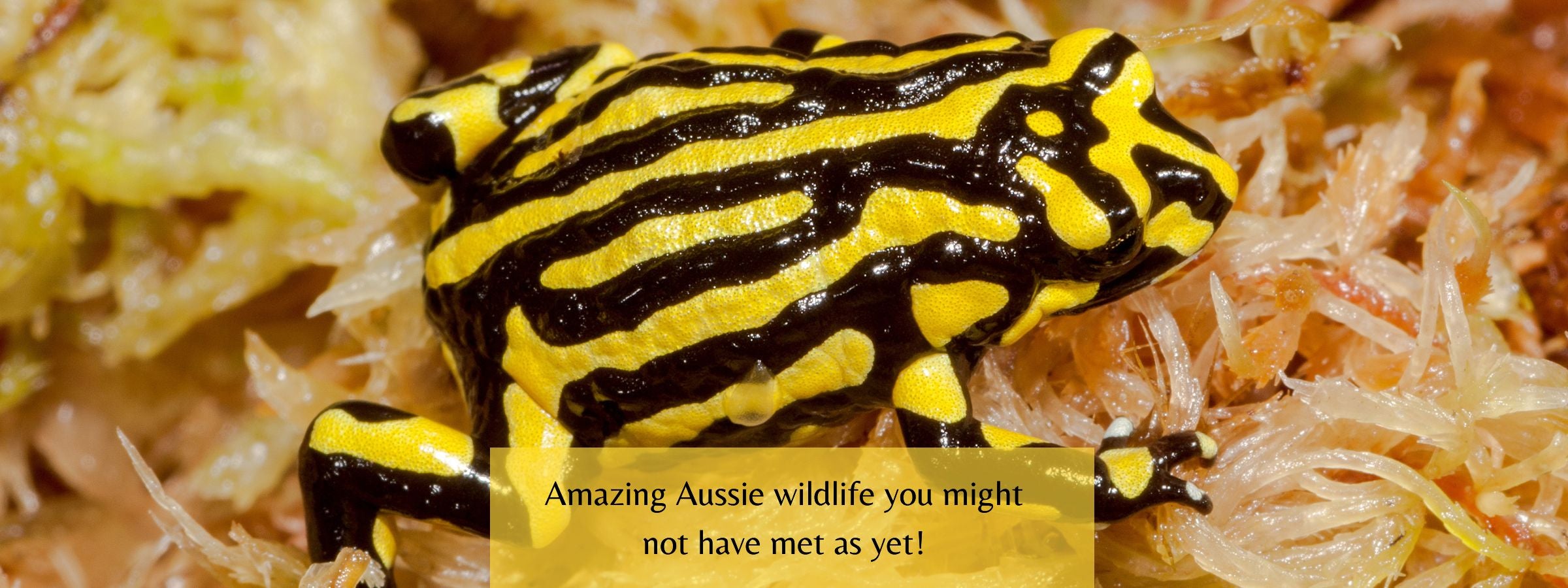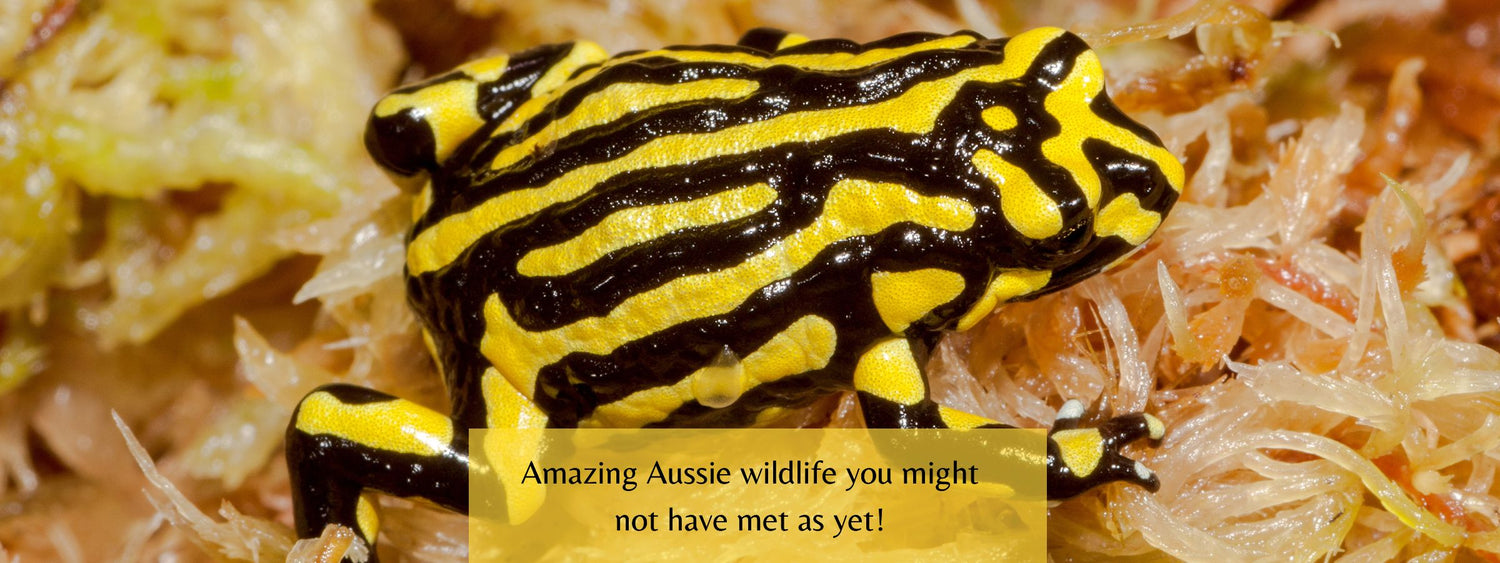Let’s start with the Numbat...
Did you know that there are less than 1,000 of these very cute Aussie animals living in the wild?
Their fave food is termites, and they have a very long, thin, sticky tongue to help them remove the termites as they leave the mound - their fast food walks right onto their tongue!.
Numbats eat 15,000-20,000 live termites every day in their natural diet! Amazing! 😊

In fenced areas, where predators are kept out, there are some populations steadily growing in numbers but our wonderful, endangered numbats are very precious.
Numbats only feed during the daytime and live in eucalypt woodlands where old and fallen trees provide hollow logs for shelter, nest sites and good conditions for foraging.
They also don't need water to drink because they get all the water they need from their food. This is very handy in the dry bush areas where they live – which is currently only in Western Australia.
'Watercooler share': Numbats are one of the closest living relatives to the now extinct Tasmanian tiger. (The other animal related to the Tassy Tiger is the Tasmanian devil.)
Have you spotted a Spotted Quoll?
Have you ever heard of a chuditch? It’s the Noongar name for a Western Quoll. How cute are these spotty quolls?!

In the past, the Western Quoll was common around Western Australia. But they are now mostly only found in the south-west of WA - in Jarrah forests - where they are listed as ‘vulnerable’.
The Australian Wildlife Conservancy (AWC), a charity we support, has recently reintroduced 11 quolls into their predator-controlled, 131,800-hectare, Mt Gibson Wildlife Sanctuary on the northern edge of the WA Wheatbelt. This has been done to keep them safe from foxes and feral cats. They are the 10th species to be released into this Sanctuary.
Western Quolls live up to four years and are about the size of a domestic cat – but with cute spots. They are Western Australia’s largest carnivorous marsupial and they hunt on the ground at night.
Recently in Orange, NSW there was an unexpected sighting of a spotted-tailed Quoll in a local resident’s shed. These quolls were thought to be extinct in the area so it’s very heart-warming that a - slightly worse for wear - quoll turned up. 💟
The local wildlife rescue group were not initially convinced that it could be a quoll. But a photo answered their questions quickly. They collected and cared for the quoll for a few days, so he could build his strength up and he is now safely back in the wild on a nearby reserve.
The discovery is great news because it means that there is probably a local quoll group somewhere near the reserve area.
Bonus: Quolls also like snacking on things like spiders and cockroaches! 😊 Pest control in the most natural way!
Efforts are underway to reintroduce them to the eastern states in predator proofed areas, which is great news!
Sweet little Sugar Gliders
As you're aware, we support the charity Greenfleet - who plant trees to grow native forests for our very special Australian wildlife...
They have been looking after gorgeous Sugar Gliders, by making sure the most suitable trees for them are added into the mix used in tree planting projects. 🌳
Sugar Gliders are wonderful community animals. The mum and dad both look after their babies in their nest hollow - one will keep the little ones warm while the other goes out to forage for food. Then they swap roles - to ensure their babies are safe!

They live in social communities made up of a number of families living in a nest, made of dry leaves, in a tree hollow.
They are active and forage for their food at night - gliding up to 50 metres at a time - between trees!
They eat insects, nectar, and pollen - and with their huge appetite for all things sweet - Sugar Gliders are believed to be important pollinators of many Banksia species.
The Beautiful Bilby
Did you know that bilbies are very important ‘ecological engineers’ in our Australian bush?
They poke their noses into the soil, scratch around, do lots of shallow and deep digging and create amazing underground burrows!
And because of all this soil engineering – a female bilby has very unusual backwards facing pouch! It’s very handy when she is scattering soil everywhere, while hunting for food or building a burrow, because the soil doesn’t get into her pouch.

Bilbies are cute, and quite small, but they certainly make up for it in digging ability. They can move many tonnes of soil in just one year!
No wonder they are known to improve our soil health by mixing in organic materials, and bringing soil up to the surface where the nutrients can be used on the ground to support other plants as well.
We need more bilbies in the world! Apart from them being sooo adorable, they are regenerators for our land.
How awesome is mother nature. 💗
Mountain Pygmy Possum sleeps under the snow!
Did you know that the Mountain Pygmy Possum is Australia’s only hibernating mammal? Here’s a few interesting things you also may not know…
🌳 It's only found on some of the highest peaks of the Snowy Mountains in New South Wales and Victoria.
🌳 These tiny marsupials weigh less than 100 grams (how cute are they?) and can sleep under the snow for several months in their rocky burrows.
🌳 Reduced snow cover, recent bushfires, and the reduction of their favourite food - the famous bogong moth - are all impacting these tiny possums.

So, with wild colonies facing a tough time, a small number of captive-bred possums have been moved into a special facilty in Lithgow to begin a breeding plan. The hope is to “future-proof” the species.
Initially the aim is to breed pygmy possums in Lithgow that are more suited to warmer climates in the future.
Sooo cute! 💕
We’re very lucky to have such wonderful wildlife.
Lyrebirds - the mischievous imitators in the forest
Lyrebirds are the cheeky imitators of all kinds of sounds – even the kookaburra’s laugh! 😊
They can mimic an extraordinary range of noises, including barking dogs, car engines turning over, grunting koalas, other birds including whip birds, crying babies, mobile phone ring tones and the click of a camera! Phew!
Did you know that they can live up to 30 years old in the bush? (This surprised me too.)

And as they get older, they increase their range of song sounds - and their imitations become more complex and accurate. 🎶
But they are also shy and secretive, which means they are often heard but not seen. Amazing!
The critically endangered corroboree frog
These amazing southern Corroboree frogs are critically endangered and until a couple of years ago there were only 30 left in the wild! 😢
Luckily a collaboration between Taronga Zoo, Victoria Zoos, the National Parks and Wildlife Service - and the NSW government's Saving our Species program - has now lifted their numbers.
There are now about 150 critically endangered southern Corroboree frogs currently living in Kosciusko National Park.
Scientists are also working hard to find a solution to the deadly chytrid fungus that is killing the frogs. So increasing their population will certainly help these unique frogs to survive whilst the researchers find an answer to getting rid of the fungus.

Another positive development - after devasting bushfires in the area in 2019/2020 - has been the installation of new enclosures specifically custom built for these small, brightly-coloured frogs. These new froggy homes have been built in 5 locations to protect the Corroboree frog from that deadly fungus.
In consideration of future fires, the enclosures also come complete with irrigation systems to fire-proof them against future disasters.
Corroboree Frogs are slowly increasing in numbers - and I hope all goes well with the research, to give them a bright future ahead. 💛
Swift Parrots – swiftly disappearing
I learnt something recently... Swift Parrots are one of only three migratory parrot species on Earth!

Aren’t they beautiful? The critically endangered Swift Parrot has also been crowned the 2023 Bird of the Year by BirdLife Australia this year.
They are a migratory bird that is only found in south-eastern Australia. And their small population has declined from around 2000 birds to a recent estimate of less than 1,000 birds. 😮
Experts have suggested that this is because of loss of suitable habitat where they breed (eastern Tasmania) and in their non-breeding areas in south-eastern mainland Australia.
The Swift Parrots nest in extremely remote and rugged areas of Tasmania, and require hollows for nesting - up in the treetops of old growth forest. It’s amazing… but swift parrots require 100-year-old tree hollows!
Logging of trees is affecting their breeding hollows, because the trees with breeding hollows are being cut down. And, as you can imagine, it’s a long, long wait for more to be available! 🦜
During the breeding season, these colourful parrots love to eat nectar from Tasmanian blue gum and Black gum flowers, which are their main food source.
They also like Spotted Gum, Red Bloodwood and Swamp Mahogany gum trees, amongst others, which are found in the extremely remote areas where they nest.
Tropical Gardeners of the north – the Cassowary
The southern cassowary is the largest fruit-eating bird in the world.
It is native to the tropical forests of north-eastern Australia, Papua New Guinea, and nearby islands. The southern cassowary is an important rainforest gardener too, spreading the seeds of rainforest trees.
Sometimes the seeds are so large that only cassawaries can swallow and disperse them.

They can run at up to 50km/hr, have a very dangerous kick (it can kill a person), and you should not approach them.
Some people do hand feed or leave out food for cassowaries, but this has many negative effects on the big birds.
They may become dependent on people to feed them, and starve if the food source is removed. They can also be hit by a vehicle if the food is left in an area near a road. In urban areas it can make the cassowaries more exposed to dog attacks.
These colourful, big birds are deserving of respect - keep well out of their way!
BONUS:
Here’s some surprising facts about our other - more familiar - wildlife that you may not be aware of…
Wonderful wandering Wombats
Did you know that wombats are the largest burrowing animals in the world?
Here's a couple of other fun facts about wombats...
🤎 They are only found in Australia.
🤎 Surprisingly, their pouches face backwards – although it makes sense, when Mum wombat has to do a lot of digging to keep the home up to scratch! (excuse the pun.) 😊
🤎 And, if you have been watching my socials, you’ll know they also have square poo !

Researchers think that there is a reason for them having poo that is cube-shaped – which they prefer to leave on a rock or raised area. It tells other wombats, that wander by, whose territory it is!
Conveniently, square poo is less likely to roll off from these higher places.
With a population of just 315 wombats (and in the past it has been as low as 35 wombats!) the Northern Hairy Nosed Wombat is still critically endangered.
Did you know that their numbers now are currently lower than the Panda bear and Black Rhinoceros? 😮
There are now two colonies of Northern Hairy-nosed Wombats in existence - a ‘stronghold’ at Epping Forest National Park and a second ‘insurance’ population at the Richard Underwood Nature Refuge (RUNR) in south-west Queensland.
Keep an eye open on our socials for future updates on these rare wombats - as soon as I hear anything. 😊
Echidnas can swim, you know!
Echidnas are wonderful and it’s special when you see them in the wild – or even waddling past your veranda if you’re lucky (like we did once)!
They also form up into ‘trains’ in mating season – the males will all follow each other in a single line when following a female. Trains can consist of 3-5 males up to about 11. They will all diligently follow a female around (often at a slow pace) until only one is left to join her - to mate and have future baby puggles.
Echidnas also use their snout – which acts as a handy snorkel - if they venture out into the waves at the beach or take a dip in a river.

Surprisingly they are quite good little swimmers! (This photo is from an earlier video on our FB & IG of one at the beach.)
Playful Platypus - in a shining coat!
Most of us are aware of our very special and amazing platypuses.
But did you know that - in 2020 - researchers in the USA shone a 'black' (UV) light on some preserved platypus pelts in storage - not expecting any result.
And surprisingly found out that the pelts were glowing strongly, in different colours (a bit like a UV black light at a 1980’s disco)! 😄

Recently researchers have made exciting discoveries about more of our Australian mammals who share this glowing trait!
Did you know that a baby platypus is called a 'puggle'. 😊
Tasmanian Devils glow blue...
Researchers were inspired to check Tasmanian Devils as well - after hearing the news of the UV glow discovery on platypuses.
The Tasmanian devil’s snout, eyes and inside of their ears glow blue under ultraviolet light when it is shone on them. How amazing is that!? 😮

Does this special biofluorescence have an important role in the Tassie devil’s lifestyle? No-one is sure yet, but studies are being done to see if they can find out more.
Bookmark this blog for sharing a few of these amazing Aussie fauna facts over the Christmas break - they are great conversation starters!
I hope you have enjoyed reading this blog as much as I did putting it together. 💚
Which was your favourite animal, bird or frog in this blog?
Let us know in the comments below – we love to hear your thoughts…
This blog will be here to share, re-visit, and (I hope) inspire for the future.
And if you enjoyed this blog, please help us share it - by letting a friend know about our Twizzle Designs Earth-friendly blog.
Twizzle Designs stocks truly sustainable, Australian made, eco-friendly gifts for your friends and family, for all occasions. 🎀
We also donate to:
💚 Planting trees
💚 Supporting conservation of Australian native wildlife, and
💚 Helping to save our planet by donating to environmentally aware charities.
Because these are the things that are close to our heart. 😊





